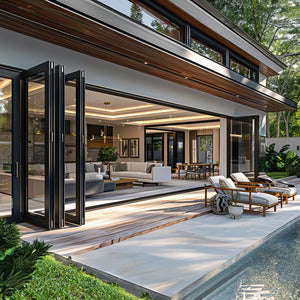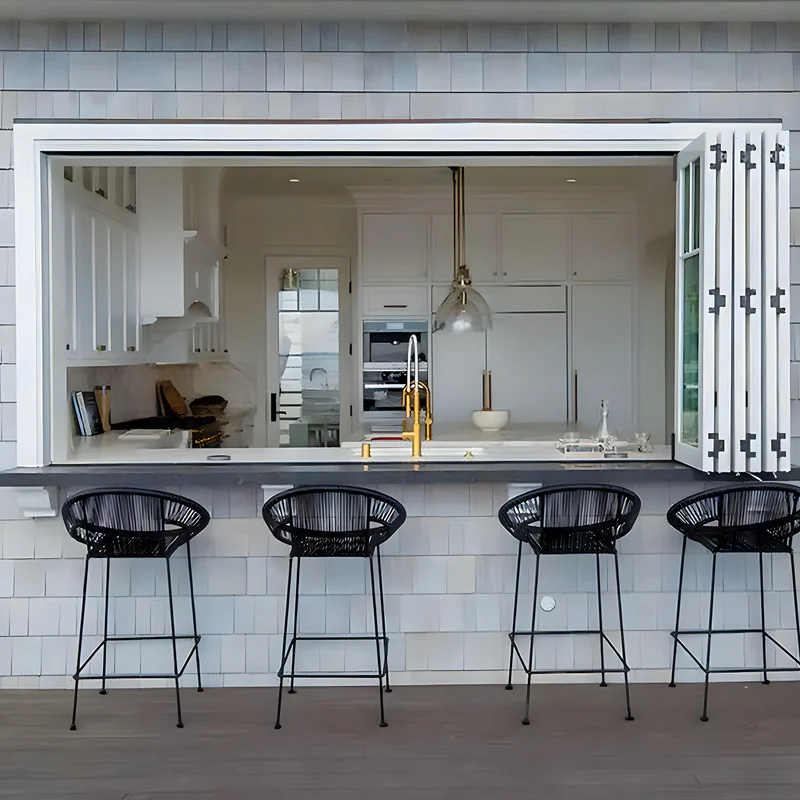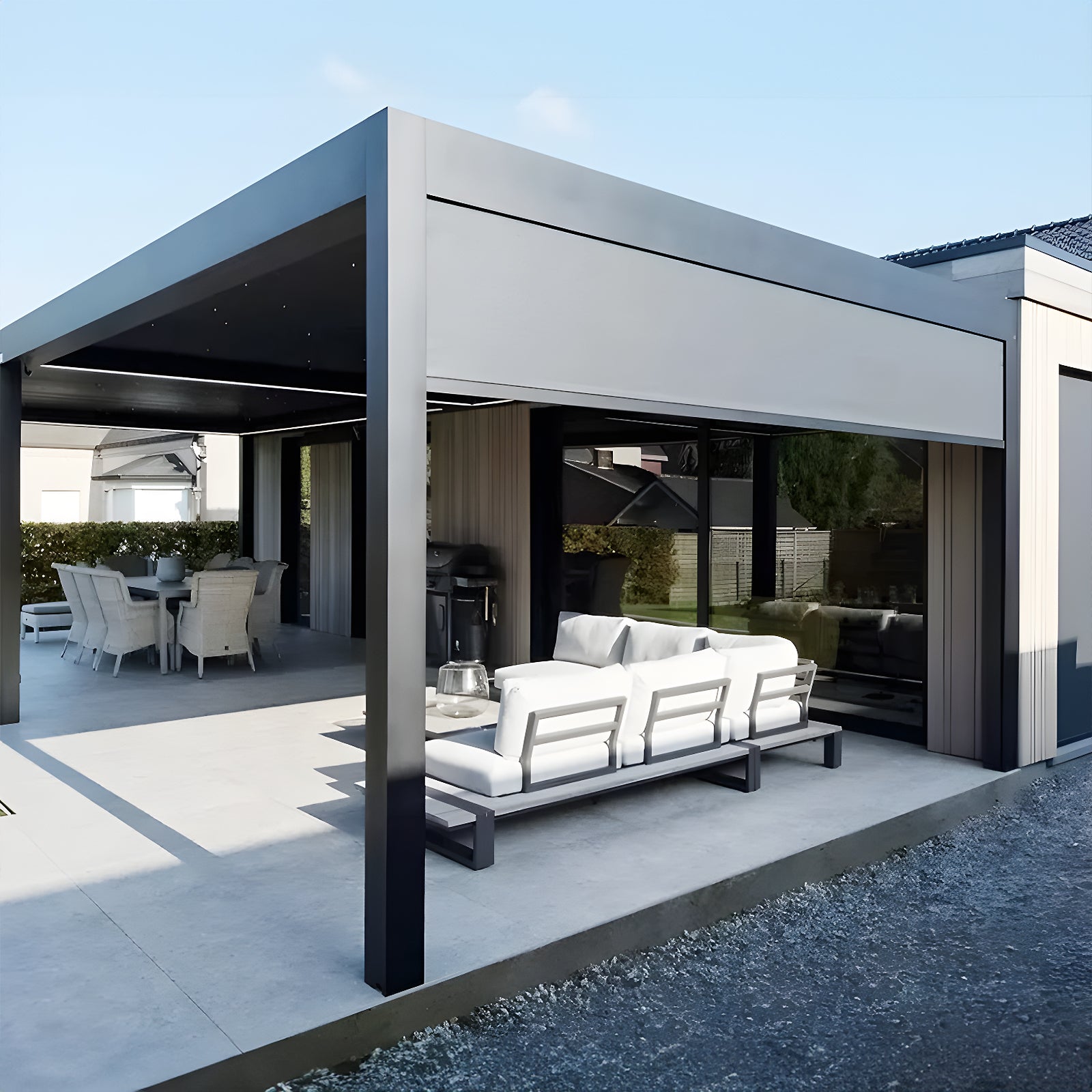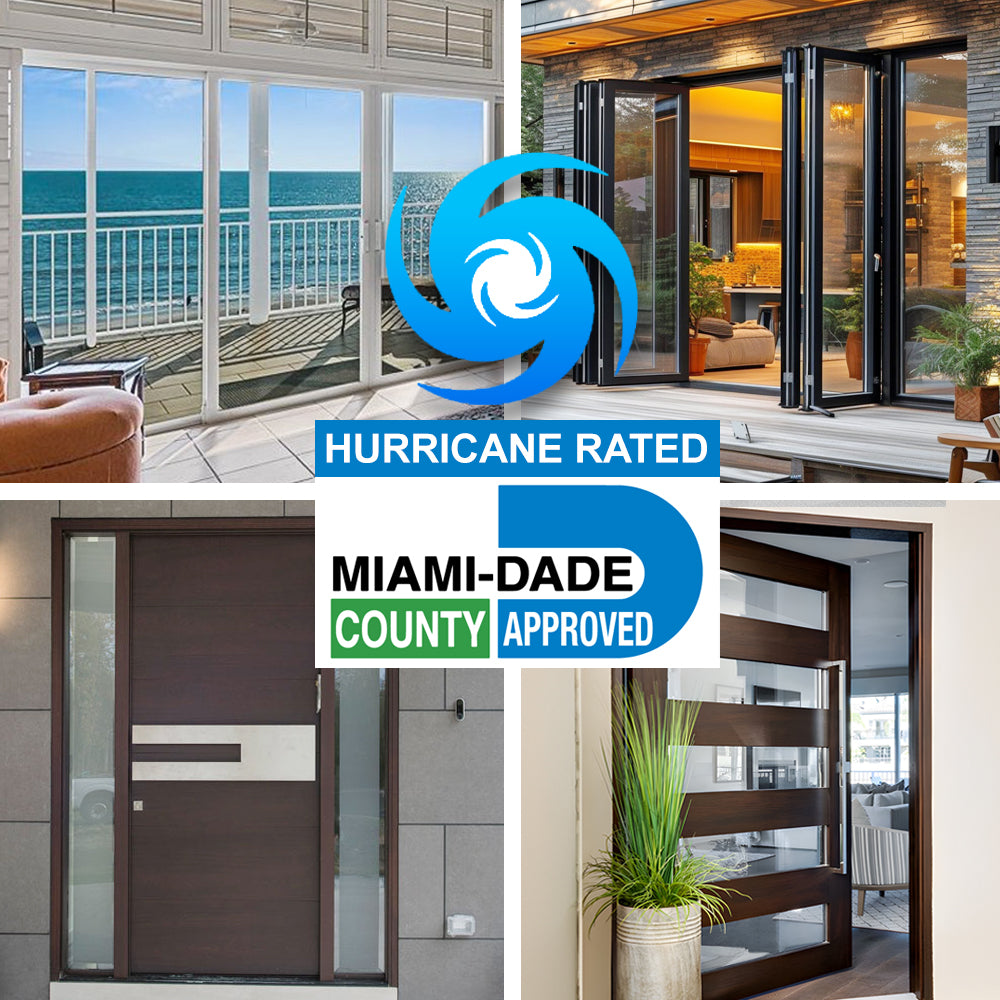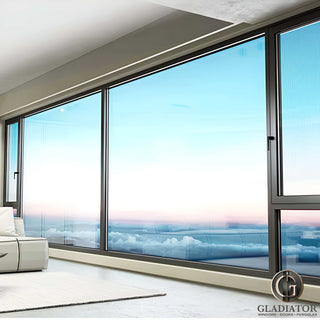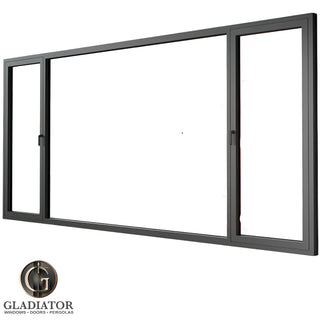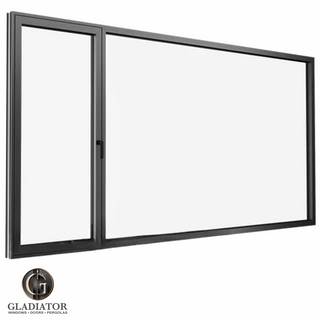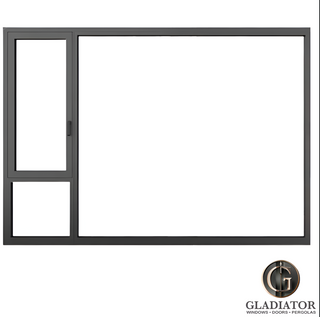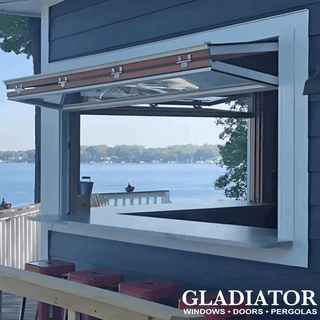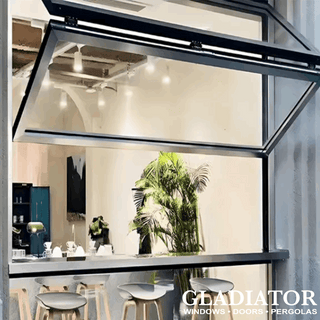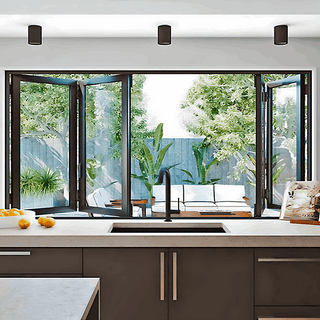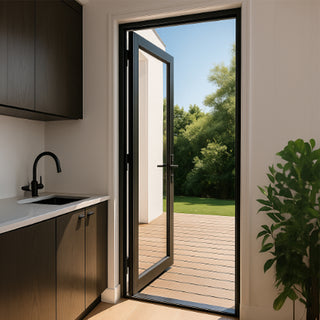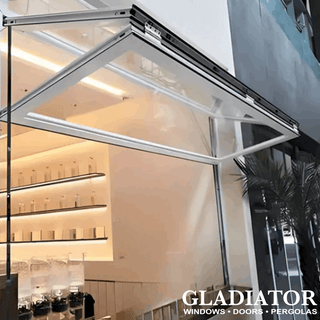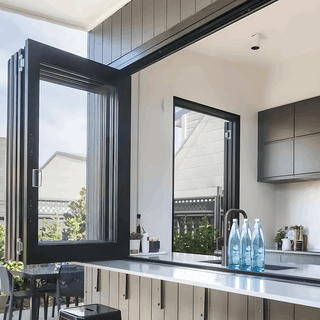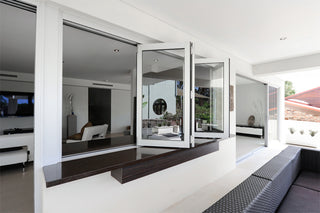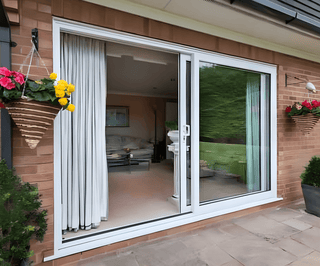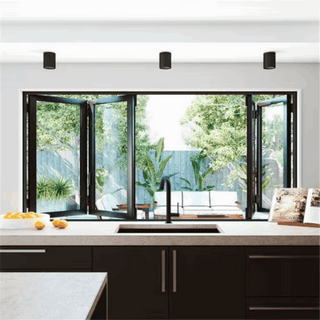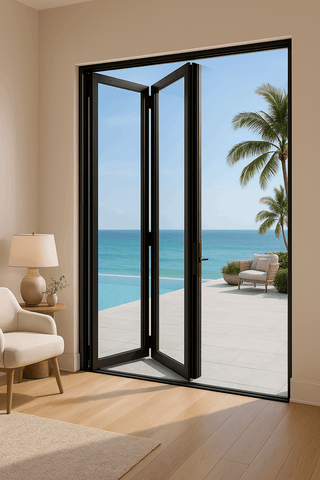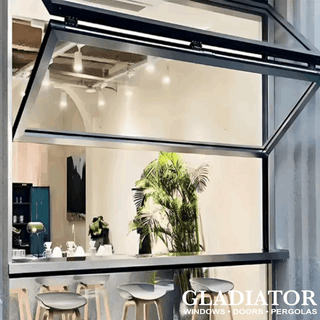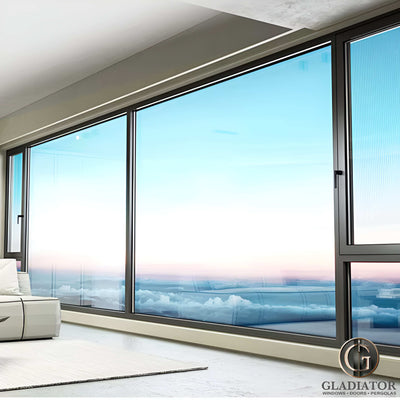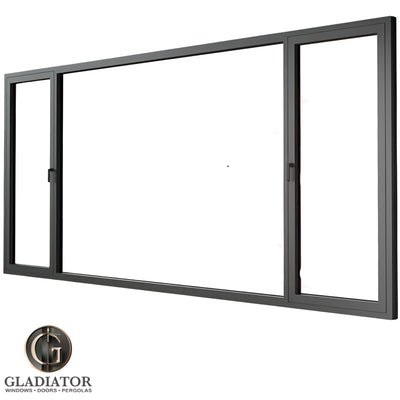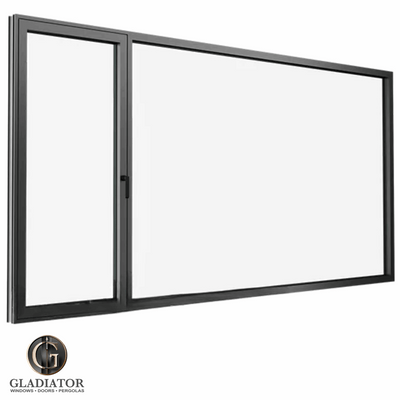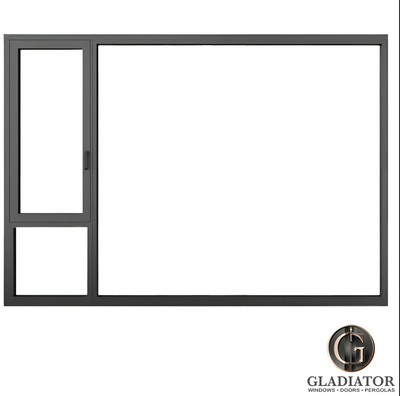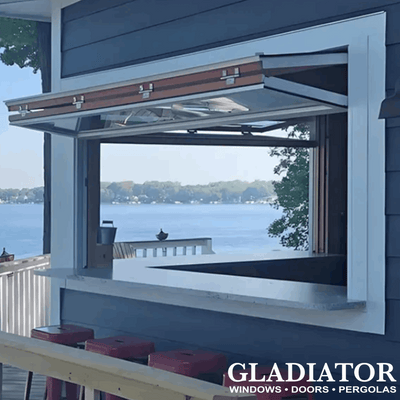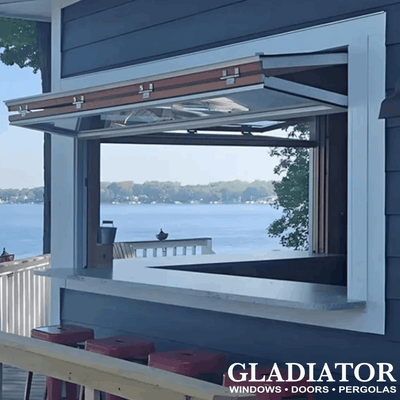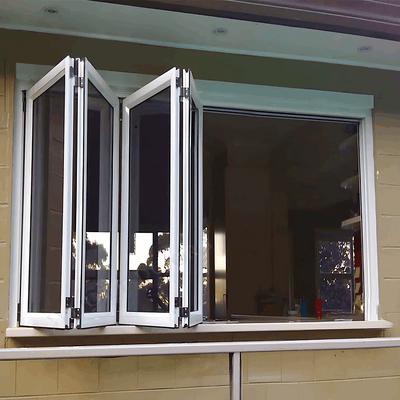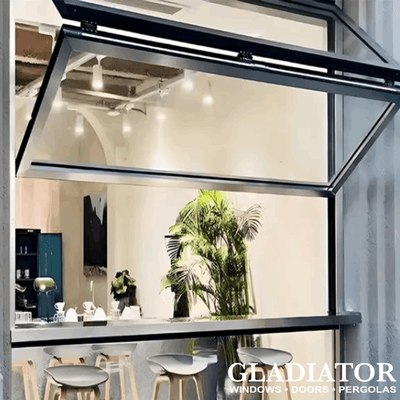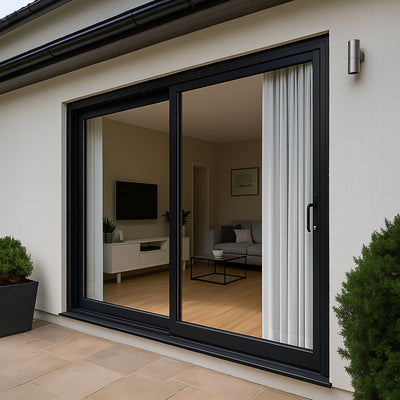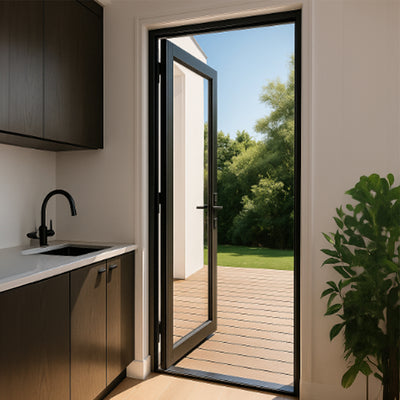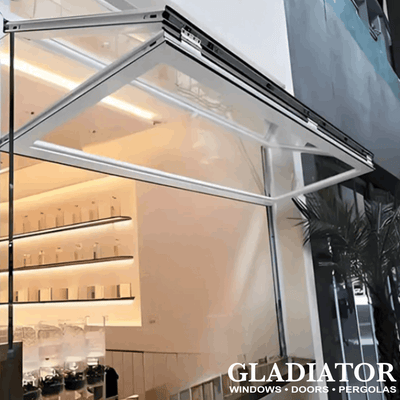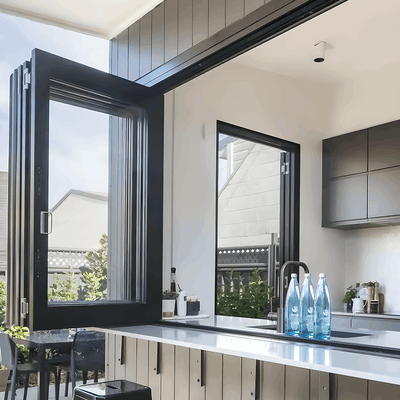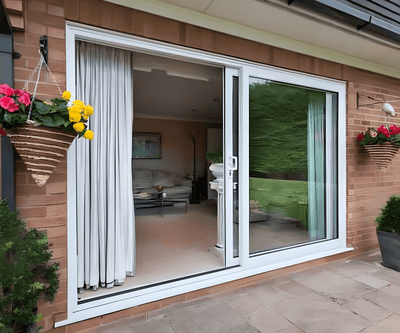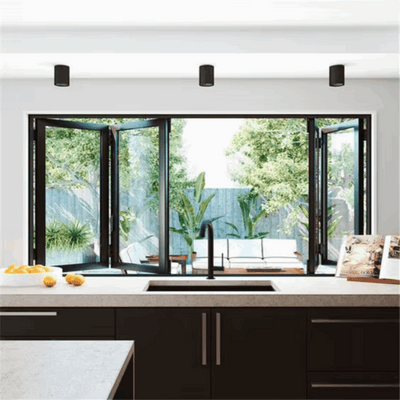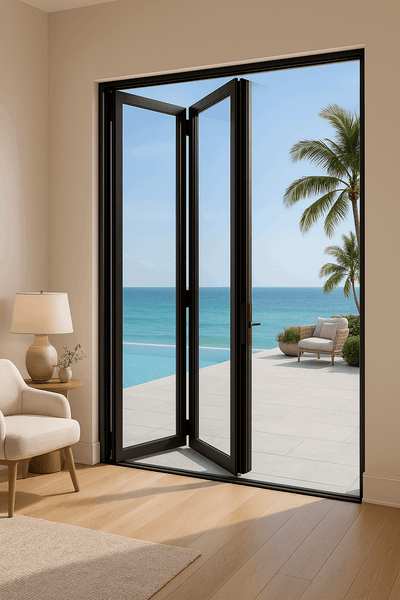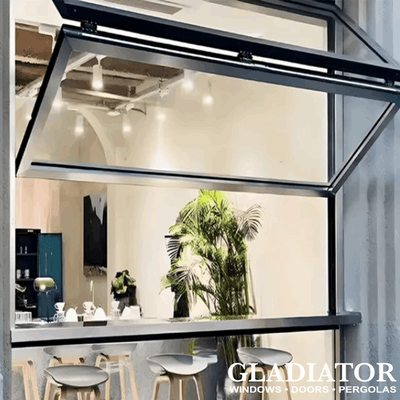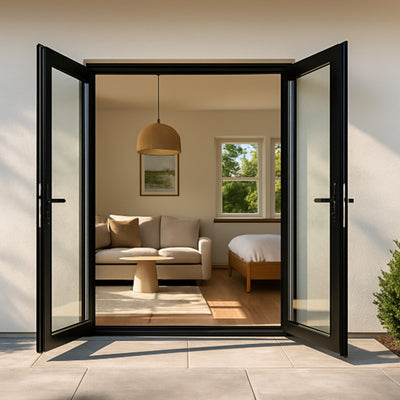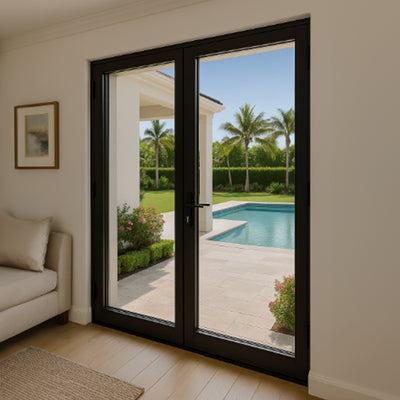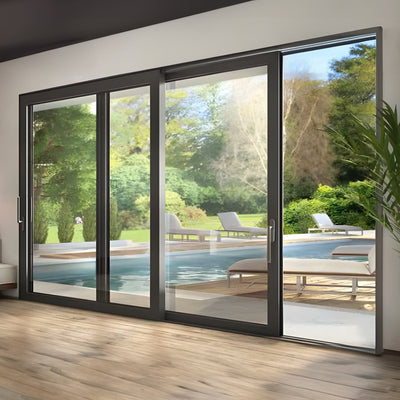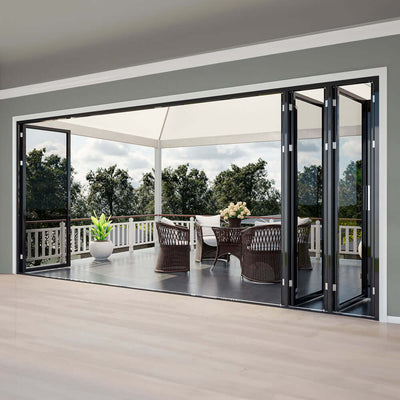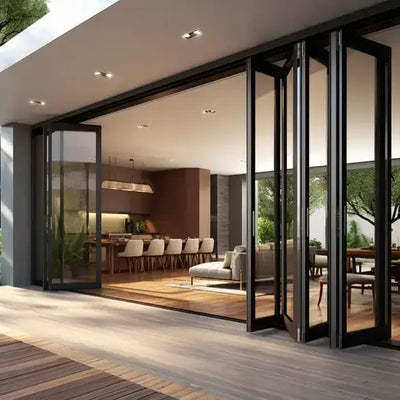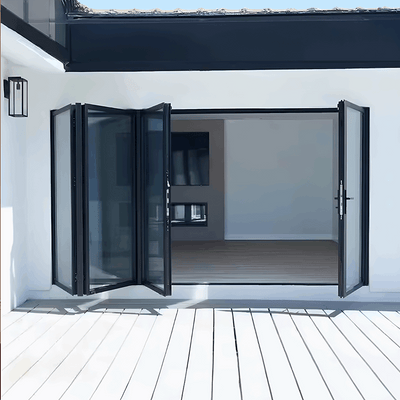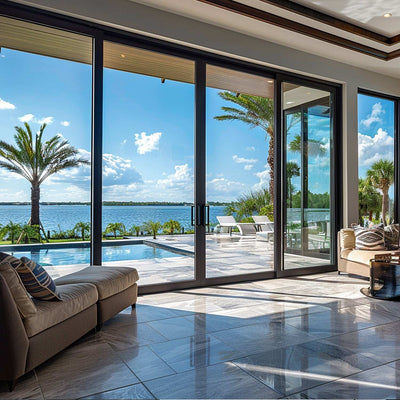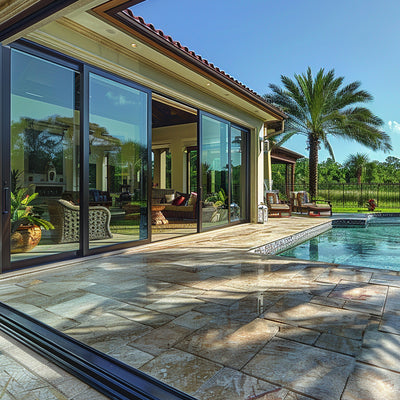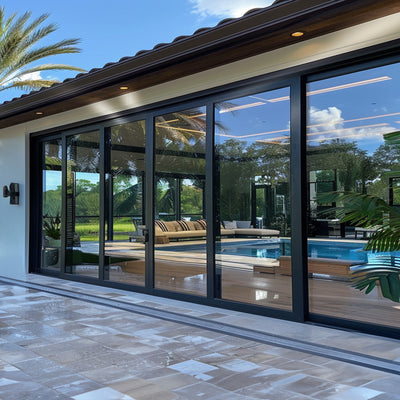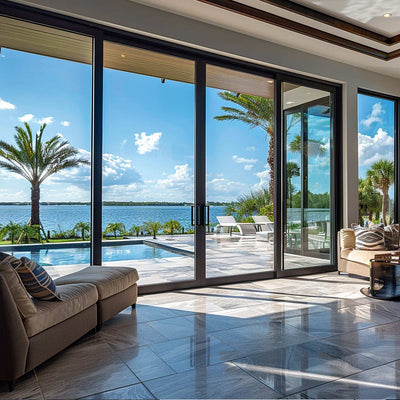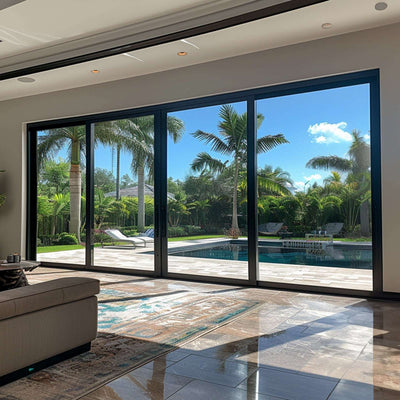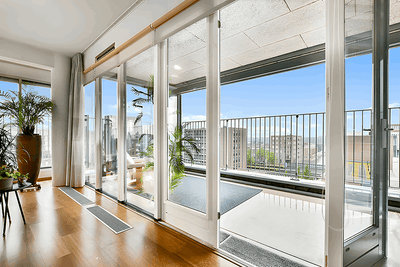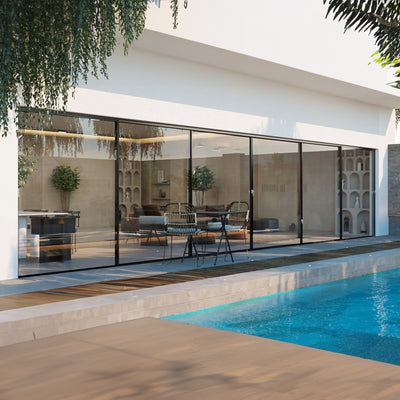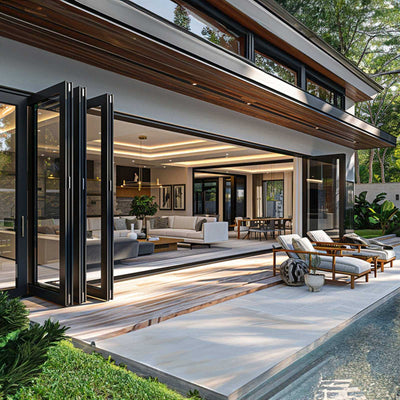Unlocking the Right Commercial Door
Choosing the right commercial door can be challenging. This guide provides a quick overview of ten popular commercial door types to help you find the perfect fit for your needs. We'll cover key features and benefits of options like storefront doors, fire-rated doors, security doors, and more, so you can make an informed decision for your building. Whether renovating or building new, this list simplifies the selection process.
1. Gladiator Window and Doors
Gladiator Window and Doors distinguishes itself as a premier manufacturer specializing in large-scale, custom-made door and window solutions for both residential and commercial projects. Their focus on innovative styles like extra-large sliding, pivot, bi-fold, and panoramic doors, along with folding windows and pergolas, caters to modern architectural trends and the desire for expansive, light-filled spaces. This makes them an excellent choice for projects where maximizing natural light and creating seamless transitions between indoor and outdoor areas are key priorities.
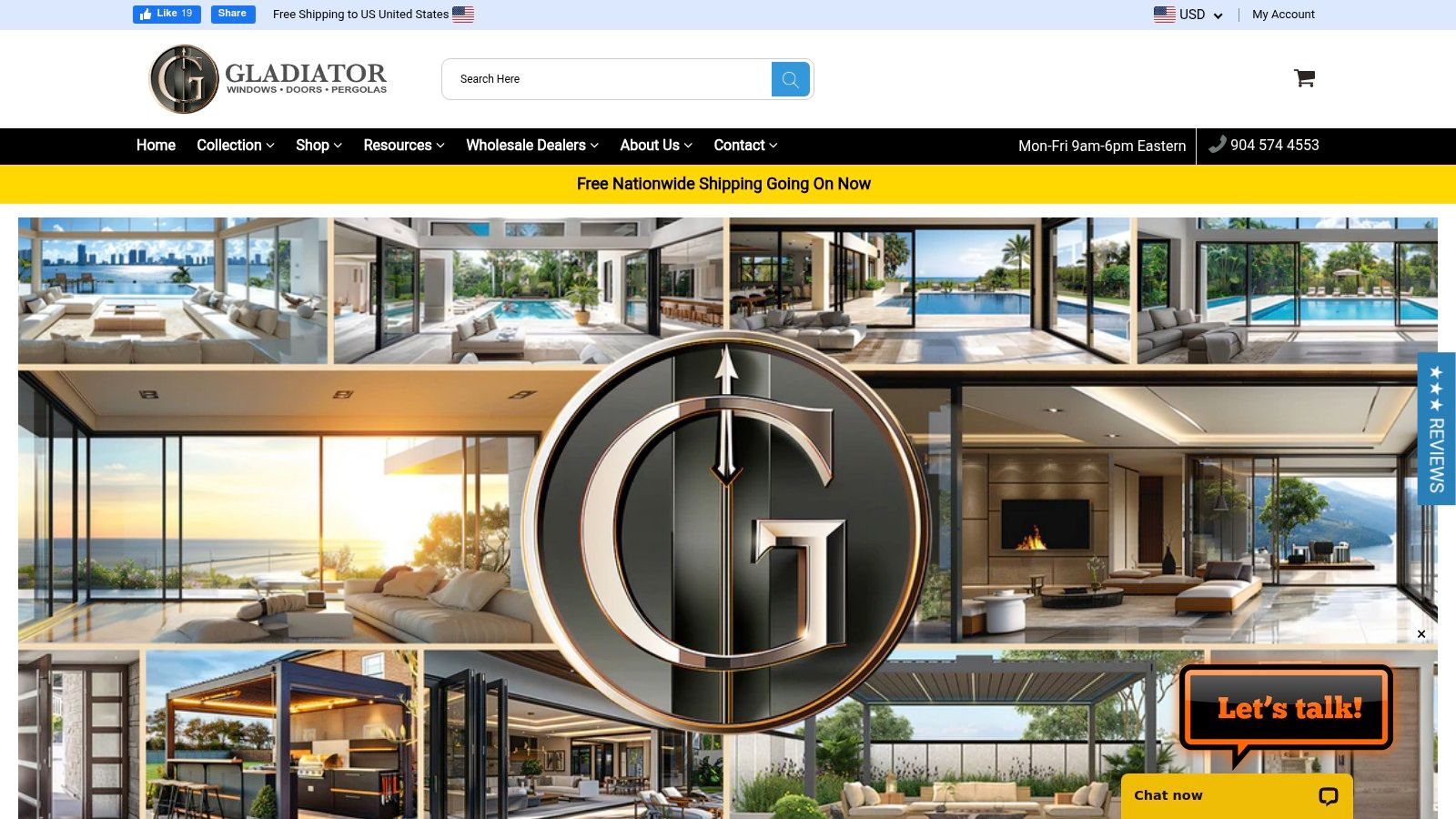
Practical Applications & Use Cases:
- Commercial Spaces: Gladiator's large-format doors are ideal for restaurants, retail stores, and offices seeking to create a modern, inviting aesthetic. Their panoramic doors can transform a storefront, blurring the lines between the interior and exterior, while their bi-fold doors can be used to create flexible spaces for conferences or events.
- High-End Residential: Homeowners seeking to elevate their living spaces with dramatic architectural features will find Gladiator's offerings appealing. Their extra-large sliding and pivot doors can create stunning entrances and seamlessly integrate indoor and outdoor living areas. Folding windows can transform a kitchen or dining area into an open-air space.
- Renovations & New Construction: Whether renovating an existing structure or building from the ground up, Gladiator's custom-made approach allows for perfect integration with the project's design. Their thermally rated products contribute to energy efficiency, a crucial factor in modern building practices.
Pricing & Technical Requirements:
While specific pricing isn't readily available on their website, Gladiator emphasizes a "Best Offer Guarantee," suggesting a competitive pricing strategy. Due to the custom nature of their products, obtaining a quote requires contacting them directly. Technical requirements will vary based on the specific product and project, making direct consultation with Gladiator essential for planning and installation.
Comparison with Similar Tools:
While other manufacturers offer large-format doors and windows, Gladiator sets itself apart with its emphasis on customization, the breadth of its innovative styles, and its Best Offer Guarantee. This combination of flexibility, innovation, and competitive pricing makes them a compelling option.
Implementation & Setup Tips:
- Consult Early: Engage with Gladiator early in the design phase to discuss your project's specific requirements and explore customization options.
- Professional Installation: Given the size and complexity of these products, professional installation is highly recommended to ensure proper functionality and performance. Factor installation costs into your budget.
- Lead Times: Be mindful that custom fabrication may require longer lead times than purchasing off-the-shelf products. Plan accordingly to avoid project delays.
Pros & Cons:
Pros:
- Unmatched affordability with a Best Offer Guarantee.
- Custom-made designs for superior performance and energy efficiency.
- Wide range of innovative styles.
- Industry-leading warranty and craftsmanship.
- Successful track record with a diverse clientele.
Cons:
- Customization may require longer lead times.
- Professional installation is recommended, adding to project costs.
Website: https://gladiatorwindowanddoors.com
Gladiator Window and Doors earns its place on this list by offering a compelling blend of innovation, customization, and competitive pricing. Their focus on large-format, thermally rated products caters to the growing demand for modern, energy-efficient designs in both residential and commercial construction. While custom fabrication and professional installation may require careful planning, the potential to transform a space with their unique offerings makes Gladiator a valuable resource for homeowners, contractors, and developers alike.
2. Hollow Metal Doors
Hollow metal doors are the workhorses of commercial and industrial buildings, providing robust security, fire protection, and durability. Constructed with steel face sheets wrapped around a reinforced core, these doors are designed to withstand heavy use and harsh conditions. Their versatility makes them suitable for a wide range of applications, from interior doorways and stairwells to exterior entrances and security checkpoints. You'll commonly find them in offices, schools, hospitals, warehouses, and retail spaces.
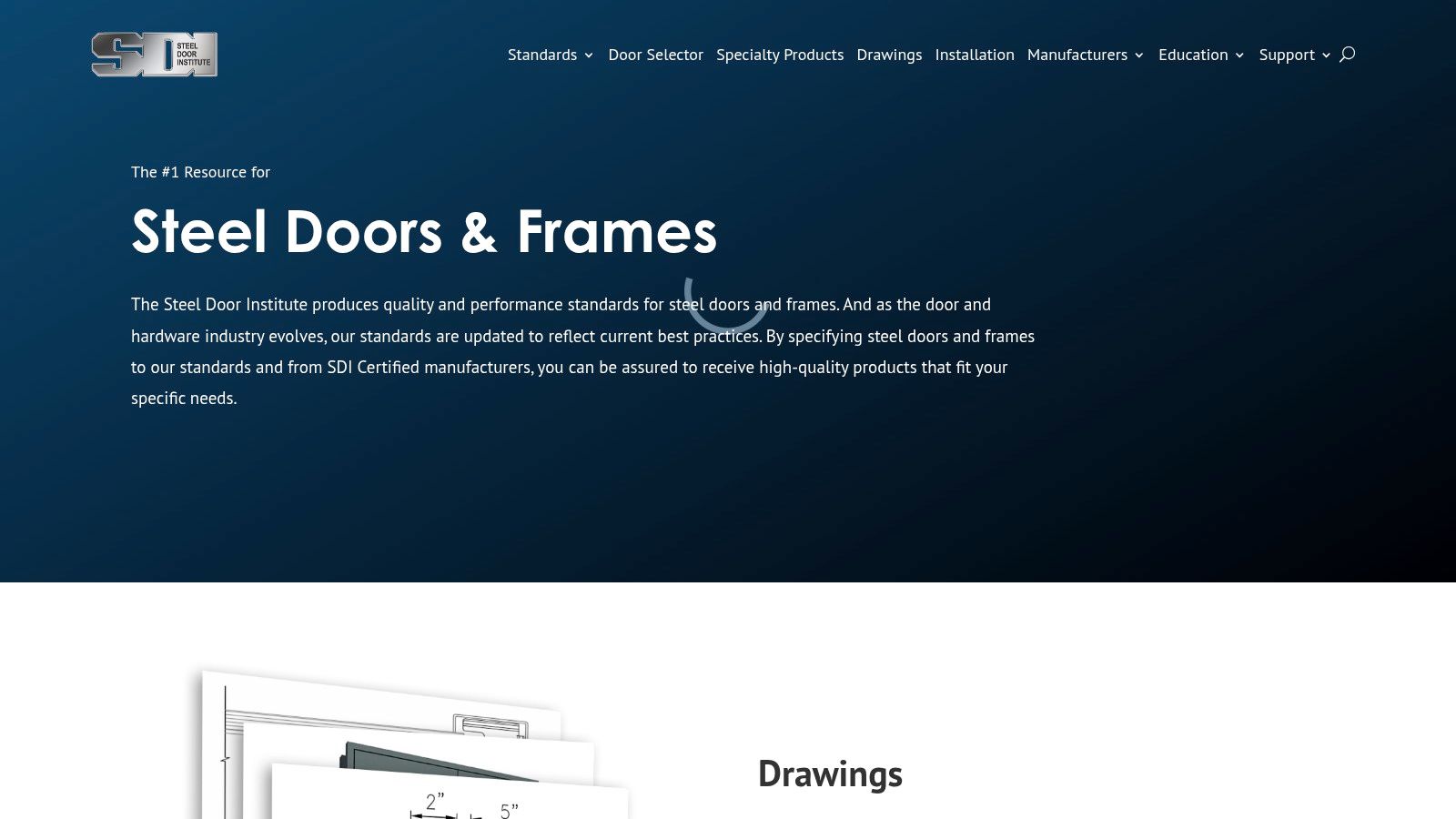
The core material of a hollow metal door plays a crucial role in its performance. While honeycomb cores offer a lightweight and cost-effective solution for standard applications, more demanding environments requiring fire resistance benefit from mineral core options. These specialized cores provide fire ratings of up to 3 hours, crucial for ensuring life safety in commercial buildings. Polystyrene or polyurethane cores also offer sound dampening qualities, making them suitable for areas where noise reduction is important.
Hollow metal doors are available in a variety of gauges, with 18, 16, and 14 gauge being the most common. Lower gauge numbers indicate thicker steel and greater durability. They can also be fabricated in custom sizes and configurations to perfectly fit any opening. For enhanced corrosion resistance, especially in exterior applications or humid environments, galvannealed or stainless steel options are available. Further customization is possible with features like sound transmission control, vision lites, and various hardware preps.
For homeowners, contractors, and developers, understanding the benefits and drawbacks of hollow metal doors is crucial. Their exceptional durability, security, and fire resistance make them a cost-effective long-term solution. The low maintenance requirements also contribute to their overall value. However, it’s important to consider that they are heavier than wood or fiberglass doors, requiring robust frames and appropriate hardware. While inherently strong, they can dent under significant impact. Furthermore, achieving specific aesthetic goals might require additional finishing, which can add to the project cost.
While pricing varies depending on size, gauge, core material, and features, hollow metal doors generally offer excellent value compared to other commercial-grade door options. For a deeper dive into available options and specifications, you can learn more about Hollow Metal Doors. When selecting hardware, ensure it's rated for the weight of the door to prevent sagging or operational issues. Finally, consulting with a qualified door installer is recommended, especially for fire-rated applications, to guarantee proper installation and code compliance. For more technical information on steel doors and frames, visit https://www.steeldoor.org.
3. Aluminum Storefront Doors
Aluminum storefront doors are a staple in commercial architecture, offering a blend of functionality and modern aesthetics. Their prevalence in retail spaces, offices, and restaurants underscores their versatility and adaptability to various business needs. These doors are designed with high-traffic flow in mind, making them ideal for main entrances and heavily used access points. Their defining characteristic is the prominent use of glass panels framed by aluminum, maximizing natural light and providing a welcoming, open feel.
Practical Applications and Use Cases:
- Retail Stores: The large glass panels offer excellent product visibility from the exterior, enticing window shoppers and creating a bright, inviting atmosphere within.
- Restaurants and Cafes: Storefront doors create a seamless transition between indoor and outdoor dining areas, enhancing the customer experience and maximizing natural light.
- Office Buildings: These doors project a professional and modern image while allowing ample natural light into reception areas and lobbies.
- Commercial and Industrial Buildings: Aluminum storefront doors provide a durable and secure entrance solution for warehouses, manufacturing facilities, and other industrial settings, often incorporating features like panic bars for emergency exits.
Features and Benefits:
- Visibility and Natural Light: The expansive glass panels maximize natural light penetration, reducing the need for artificial lighting and creating a brighter, more welcoming environment. This also enhances security by providing clear visibility both inside and out.
- Lightweight and Durable: Aluminum is a lightweight yet strong material, making the doors easy to operate and resistant to wear and tear in high-traffic areas.
- Customization: Aluminum storefront doors are highly customizable. They are available in a wide array of finishes and colors, allowing you to match your building's aesthetic. Glass options include tempered or insulated glass for enhanced safety and energy efficiency. Narrow, medium, and wide stile options further contribute to design flexibility. You can also select from various hardware options to meet specific security and accessibility requirements.
- ADA Compliance: Configurations are available to meet Americans with Disabilities Act (ADA) standards, ensuring accessibility for all individuals. This often involves specific hardware choices and adherence to door opening force requirements.
- Recyclable Materials: Aluminum is a highly recyclable material, making these doors an environmentally friendly choice.
Pros and Cons:
Pros:
- Excellent visibility and light transmission
- Relatively lightweight and easy to operate
- Contemporary and customizable aesthetic
- Durable and long-lasting
- Recyclable materials
Cons:
- Less insulation than solid doors, potentially impacting energy efficiency. Insulated glass options can mitigate this to some extent.
- Can be a security vulnerability without additional features such as reinforced glass, robust locking mechanisms, and security grilles.
- Cost can be significant, especially with premium finishes and advanced glazing options.
Pricing and Technical Requirements:
Pricing for aluminum storefront doors varies considerably depending on size, glass type, finish, hardware, and installation complexity. It's crucial to consult with a qualified contractor or supplier for accurate pricing based on your specific project requirements. Technical requirements are often dictated by local building codes and accessibility standards. The American Architectural Manufacturers Association (AAMA) provides valuable resources and standards related to storefront door performance and installation (https://www.aama.org).
Implementation and Setup Tips:
- Engage a qualified and experienced contractor specializing in commercial door installation. Proper installation is critical for performance, safety, and code compliance.
- Carefully consider the specific needs of your building, including traffic flow, security requirements, and energy efficiency goals.
- Obtain detailed specifications and quotes from multiple suppliers to ensure competitive pricing and suitable product options.
- Ensure that the chosen door and hardware meet all relevant building codes and ADA accessibility guidelines.
Why Aluminum Storefront Doors Deserve Their Place on the List:
Aluminum storefront doors offer a compelling combination of functionality, aesthetics, and durability, making them a popular and effective entrance solution for a wide variety of commercial applications. Their ability to maximize natural light, enhance visibility, and create a welcoming ambiance contributes significantly to the overall appeal and functionality of commercial spaces. While cost and security considerations warrant careful attention, the numerous benefits and customization options make aluminum storefront doors a valuable addition to this list.
4. Automatic Sliding Doors
Automatic sliding doors offer a seamless and convenient entrance solution, particularly for high-traffic environments. They leverage motion sensors or activation devices, eliminating the need for manual operation. This makes them ideal for locations where hands-free access is beneficial, such as retail stores, hospitals, airports, and office buildings. These doors can be configured in several ways, including single slide, bi-parting (where two door panels slide away from each other), or telescoping (where multiple panels slide and nest together), allowing for flexibility depending on the available space and the volume of foot traffic.

This type of door earns its spot on this list due to its blend of convenience, accessibility, and modern design. Features like motion sensor activation, programmable opening width and timing, and "break-out" capabilities for emergency egress make them a safe and adaptable choice for a variety of commercial applications. For example, a retail store can program the doors to open wider during peak hours and narrower during slower periods, optimizing energy efficiency. Hospitals benefit from the touchless operation for infection control, and individuals with mobility impairments gain easier access. Learn more about Automatic Sliding Doors to understand the range of customization options available.
While the initial cost of automatic sliding doors is generally higher than manual swing doors, the long-term benefits often outweigh the upfront investment. Factors influencing the price include the size and configuration of the door system, the type of glass used, and the sophistication of the activation and safety features. You can expect to pay significantly more for a telescoping system designed for a large entrance than a single-slide door for a smaller opening. Installation also requires specialized expertise to ensure proper wiring for the motor, sensors, and control systems. It's crucial to factor in the costs associated with ongoing maintenance, which may involve regular inspections, sensor calibration, and occasional repairs. Additionally, these doors require a reliable power source and often a backup system to ensure operation during power outages.
Compared to revolving doors, another option for high-traffic areas, automatic sliding doors offer better accessibility for individuals using wheelchairs or other mobility devices. Revolving doors can also present challenges for people with large items or strollers. However, revolving doors tend to be more energy-efficient in extreme climates as they minimize air exchange. Swing doors are a less expensive alternative but are not suitable for high-traffic applications due to their manual operation and potential to create bottlenecks.
When considering automatic sliding doors, it's vital to choose a reputable supplier and installer. Ensure they comply with all relevant safety standards and building codes (refer to resources like the American Association of Automatic Door Manufacturers - https://www.aaadm.com). Properly implemented and maintained, automatic sliding doors provide a modern, convenient, and accessible entrance solution for a variety of commercial buildings.
Pros:
- Excellent accessibility compliance
- Convenient for high-traffic areas
- Energy efficiency by minimizing open time
- Modern appearance
Cons:
- Higher initial cost than manual doors
- Requires power source and backup
- More maintenance requirements
- Potential for sensor malfunctions
5. Fire-Rated Doors
Fire-rated doors play a crucial role in safeguarding lives and property. Unlike standard doors, they are specifically engineered and rigorously tested to withstand fire and smoke for a specified period, effectively compartmentalizing a building and slowing the spread of fire. This containment is vital for allowing occupants to evacuate safely and minimizing damage. These doors are essential components of a building's passive fire protection system and are indispensable for meeting building codes and insurance requirements. They are available in various materials, including steel, wood, or composite construction, offering flexibility for different aesthetic and functional needs.
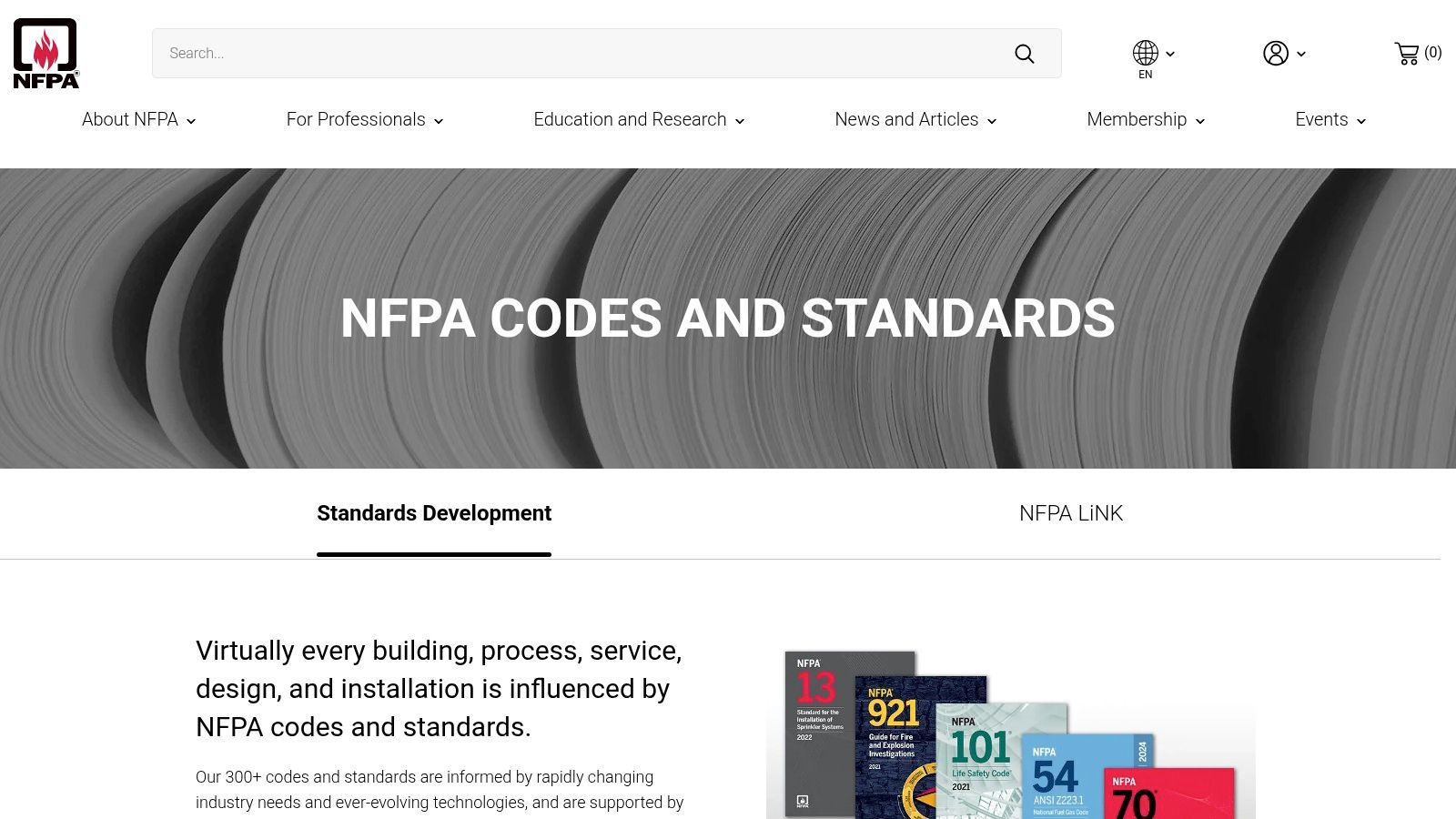
Fire-rated doors are categorized by their fire-resistance rating, typically expressed in minutes. Common ratings include 20, 45, 60, 90, and 180 minutes. The required rating for a specific location depends on factors like building occupancy type, the potential fire load, and local building codes. For example, a door leading to a boiler room or an electrical closet may require a higher rating than a door separating two offices. Learn more about Fire-Rated Doors and their specific applications.
Key features that contribute to a fire-rated door's effectiveness include self-closing and latching mechanisms to ensure the door remains closed during a fire, intumescent seals and gasketing that expand when exposed to heat to seal gaps and prevent smoke passage, and fire-rated glass options for visibility where required. These doors are tested according to stringent standards such as NFPA 252 or UL 10C to ensure they meet performance criteria. You can find more information about these standards at nfpa.org/codes-and-standards.
While fire-rated doors are generally more expensive than standard doors, the added cost is justified by their crucial life safety function. Exact pricing can vary depending on the size, material, fire rating, and specific hardware required. For instance, a standard single steel fire-rated door with a 90-minute rating might cost significantly more than a standard hollow-core interior door.
Proper installation is critical for fire-rated doors to function as intended. This typically involves specific framing requirements, hardware installation procedures, and meticulous sealing of gaps. Regular inspection and maintenance, including checking the operation of self-closing mechanisms and the integrity of seals, are also necessary to ensure ongoing compliance and performance. These doors are generally heavier than standard doors due to their construction and fire-resistant core materials, a factor to consider during installation and use.
Pros:
- Critical life safety function: Delays the spread of fire and smoke, allowing for safe evacuation and protecting property.
- Code compliance: Ensures adherence to building codes and fire safety regulations.
- Insurance benefits: May contribute to lower insurance premiums.
- Available in various aesthetic options: Can be integrated seamlessly into different architectural styles.
Cons:
- Higher cost than non-rated doors: Represents a larger upfront investment.
- Strict installation requirements: Demands specialized knowledge and precise execution.
- Regular inspection and maintenance needed: Ongoing costs for upkeep and compliance.
- Heavier than standard doors: Requires appropriate framing and hardware.
Fire-rated doors deserve their place in this list due to their vital role in fire safety. Whether you're a homeowner, contractor, or developer, understanding the importance and requirements of fire-rated doors is essential for ensuring the safety and compliance of any building project.
6. FRP (Fiberglass Reinforced Polyester) Doors
FRP (Fiberglass Reinforced Polyester) doors represent a robust and versatile solution for commercial and industrial applications where durability and hygiene are paramount. They are constructed with fiberglass reinforced polyester face sheets bonded to an internal framework, resulting in a door that can withstand considerable abuse. This makes them a worthwhile investment for specific applications, despite a higher upfront cost compared to traditional materials like steel or aluminum.
Practical Applications and Use Cases: FRP doors truly shine in demanding environments. Their resistance to corrosion, chemicals, and impact makes them ideal for:
- Food Processing Facilities: The hygienic, smooth surface is easy to clean and sanitize, meeting stringent food safety regulations. They resist bacteria growth and can withstand frequent washdowns.
- Restaurants and Kitchens: Similar to food processing plants, the durability and cleanability of FRP doors are beneficial in commercial kitchen settings.
- Hospitals and Healthcare Facilities: FRP doors can withstand harsh cleaning agents and disinfectants while providing a durable and sanitary barrier.
- Laboratories and Cleanrooms: The chemical resistance of FRP makes these doors suitable for laboratories and other controlled environments.
- Warehouses and Industrial Facilities: High-traffic areas and those exposed to potential impacts benefit from the robust construction of FRP doors.
- Coastal Areas: The corrosion resistance makes FRP doors a smart choice for buildings exposed to salt spray and humid environments.
- Exterior Entryways in Harsh Climates: FRP doors can withstand extreme temperatures, moisture, and other challenging weather conditions.
Features and Benefits:
- Exceptional Durability: FRP doors resist scratches, dents, chemicals, rot, rust, and corrosion, providing a long service life even in demanding environments.
- Low Maintenance: No painting is required, and the smooth surface is easy to clean, significantly reducing maintenance costs over time.
- Hygienic Surfaces: The non-porous surface inhibits bacterial growth and is easy to sanitize, making it ideal for hygiene-sensitive applications.
- Thermal Performance: FRP doors offer good insulation, helping to regulate temperatures and potentially reduce energy costs.
- Variety: Available with various core materials, colors, and textures to suit different needs and aesthetic preferences.
Pros and Cons:
Pros:
- Exceptional durability and long lifespan in harsh environments
- Resistant to a wide range of chemicals, impacts, and environmental factors
- Low maintenance requirements
- Hygienic and easy to clean
- Good thermal performance
Cons:
- Higher initial cost compared to steel or aluminum doors
- Limited architectural design flexibility compared to other materials
- Potential for UV degradation if not properly treated (look for UV-resistant options)
- Heavier than aluminum doors, which may require sturdier framing
Pricing and Technical Requirements:
Pricing for FRP doors varies depending on size, core material, features (such as windows or hardware), and the manufacturer. It's best to contact suppliers like Special-Lite (https://www.specialliteinc.com) directly for specific pricing. Installation typically requires professional expertise to ensure proper sealing and functionality, especially in environments requiring strict hygiene control.
Comparison to Similar Options: While steel and aluminum doors are more common and often less expensive initially, they may not offer the same level of resistance to corrosion, chemicals, and impacts as FRP. Stainless steel doors can offer similar corrosion resistance but at a significantly higher cost. For applications where hygiene, durability, and low maintenance are paramount, the long-term benefits of FRP doors often outweigh the higher initial investment.
Implementation/Setup Tips:
- Consult with a professional installer: Proper installation is crucial for maximizing the performance and lifespan of FRP doors.
- Specify UV-resistant coatings: If the door will be exposed to direct sunlight, ensure it has a UV-resistant coating to prevent degradation.
- Choose the right core material: Different core materials offer varying levels of insulation and fire resistance. Select the appropriate core based on the specific application.
- Consider hardware compatibility: Ensure that chosen hardware is compatible with FRP doors and the intended environment.
FRP doors earn their spot on this list due to their unparalleled durability and resilience in demanding environments. While the initial cost may be higher, the long-term benefits of reduced maintenance, enhanced hygiene, and extended lifespan make them a valuable investment for specific commercial and industrial applications.
7. High-Speed Doors
High-speed doors are a specialized solution designed for environments where rapid, frequent access is required, combined with a critical need to maintain environmental separation. They offer a significant advantage in minimizing air exchange and temperature fluctuations between different areas, making them ideal for temperature-controlled warehouses, manufacturing facilities, and clean rooms. These doors also contribute to improved operational efficiency by reducing wait times for personnel and vehicles, which translates to a smoother workflow and potentially increased productivity. Think of them as the fast-paced, heavy-duty siblings of standard commercial doors. Their speed and robust design make them perfect for high-traffic areas where maintaining a specific environment is paramount. For instance, a food processing plant could use high-speed doors to separate areas with different temperature requirements while ensuring efficient movement of goods and personnel.
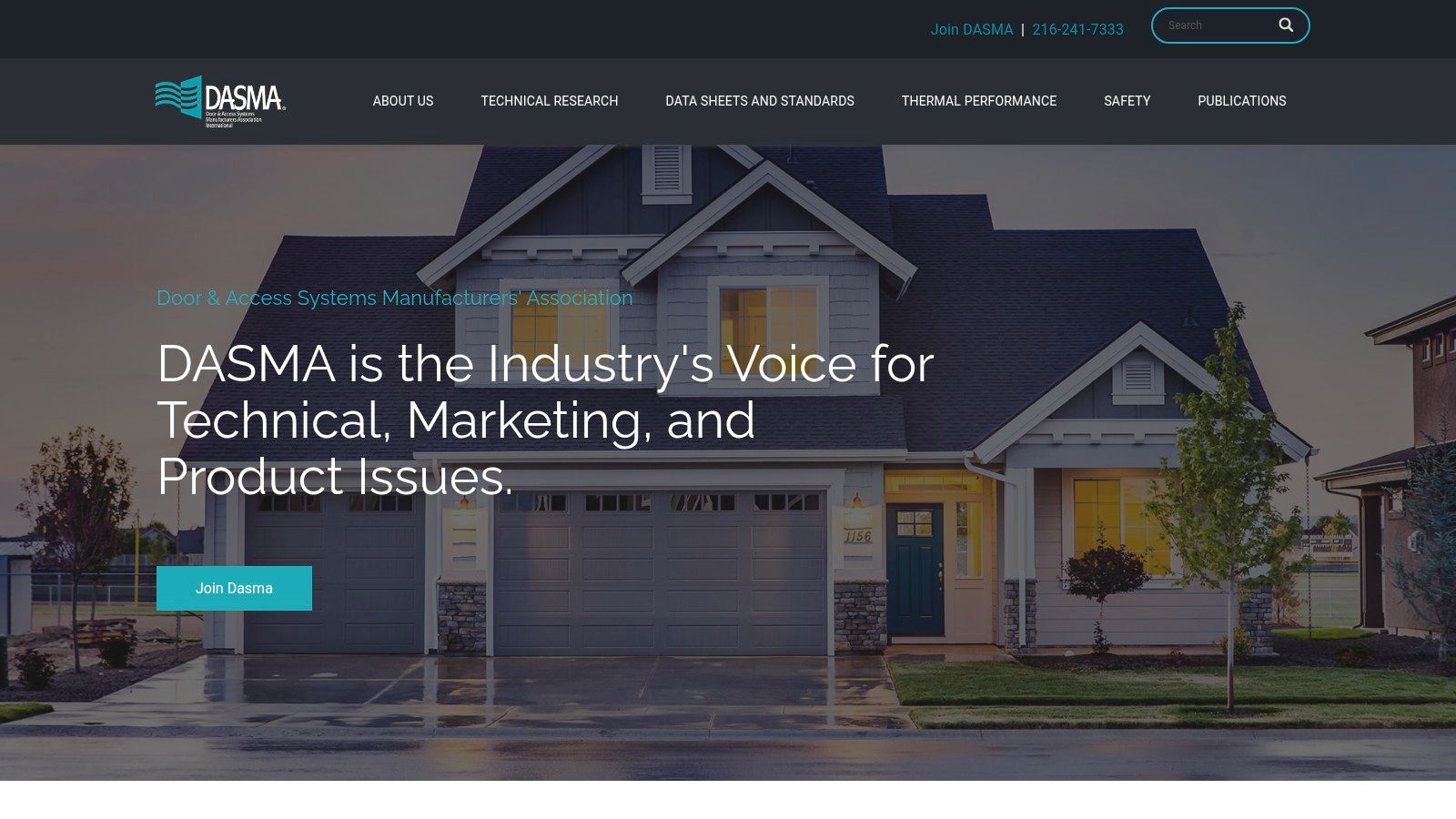
High-speed doors are available in various configurations including roll-up, folding, and sliding, each suited for specific applications. Roll-up designs are often preferred for their compact footprint and high speed, while folding doors are ideal for larger openings. Sliding doors can be a good compromise between speed and space efficiency. Features like automatic closing functionality, impact-resistant materials, and safety photo eyes enhance their practicality and safety. Specialized seals further contribute to environmental control by minimizing air leakage. Opening speeds can reach up to 100 inches per second, dramatically reducing the time a doorway is open compared to conventional doors. This rapid action helps to minimize energy loss due to air exchange, which can be a considerable factor in climate-controlled environments. While pricing can vary greatly depending on size, features, and installation complexity, high-speed doors generally represent a higher initial investment compared to traditional commercial doors. You might find Learn more about High-Speed Doors helpful for detailed technical specifications and vendor information.
Pros:
- Minimizes energy loss: Significantly reduces air exchange and temperature fluctuations between areas.
- Improves traffic flow efficiency: Faster opening and closing speeds optimize workflow.
- Reduces contamination: Maintains separation between different environments, crucial for clean rooms or food processing facilities.
- Various activation options: Offers flexibility in operation (e.g., push-button, remote control, motion sensors).
Cons:
- Higher initial investment: More expensive than traditional commercial doors.
- Specialized maintenance requirements: Regular maintenance by trained technicians is often necessary.
- Requires power for operation: Dependent on a consistent power supply for functionality.
- May require more frequent parts replacement: High-speed operation can lead to increased wear and tear on some components.
This type of door deserves a place on this list due to its specialized capabilities that cater to demanding commercial and industrial settings. While they may not be suitable for all applications, the benefits of improved environmental control, enhanced workflow efficiency, and reduced contamination make high-speed doors a valuable consideration for facilities where these factors are critical. They represent a significant step forward in door technology, prioritizing both speed and environmental integrity. If you're a commercial property owner or contractor working on a project with specific environmental and efficiency requirements, exploring high-speed doors could be a worthwhile investment. More information about commercial door standards can be found on the DASMA website: https://www.dasma.com
8. Wood and Wood Veneer Doors
Wood and wood veneer doors bring a touch of elegance and warmth to commercial spaces, making them a popular choice for offices, hotels, restaurants, and high-end retail environments. They offer a compelling alternative to metal doors where aesthetics and acoustic performance are paramount. These doors can be crafted from solid wood for a premium, traditional feel, or utilize engineered cores with real wood veneers for a more cost-effective yet visually appealing solution. This versatility allows them to fit a wide range of budgets and design preferences.
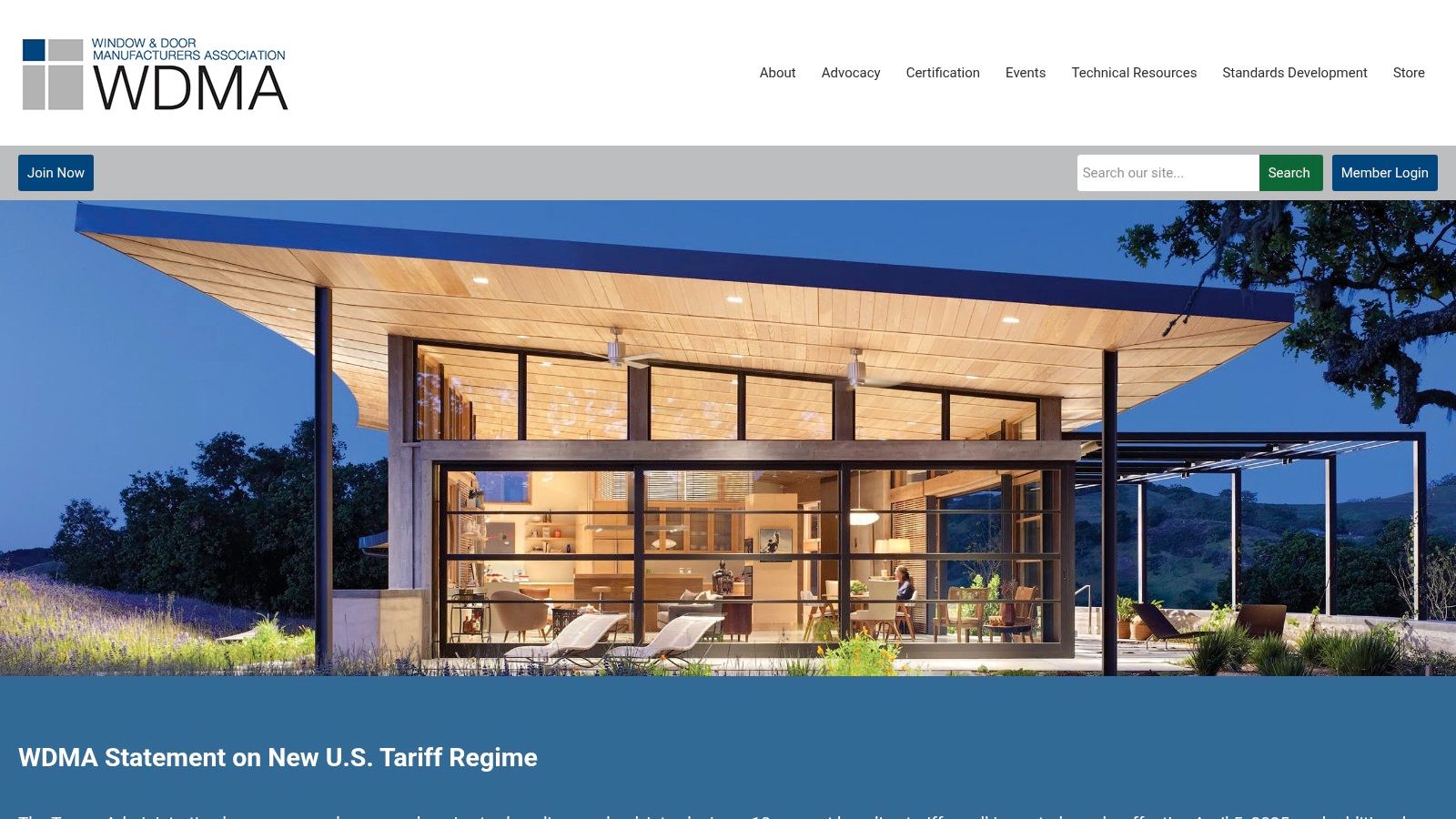
One of the significant advantages of wood and wood veneer doors is the sheer variety available. Numerous wood species, from rich mahogany to sleek maple, offer different aesthetic characteristics and can be finished with stains, paints, or varnishes to perfectly match the surrounding décor. Furthermore, these doors can be manufactured to meet specific fire ratings (up to 90 minutes) and sound transmission control requirements, making them suitable for a variety of building codes and applications. Custom designs, including intricate detailing and carving, are also possible, allowing for truly unique and personalized entrances. For environmentally conscious projects, sustainably harvested and certified wood options are readily available.
Features and Benefits:
- Variety of Wood Species and Finishes: Choose from a wide selection to match any design aesthetic.
- Fire Ratings: Available with fire ratings up to 90 minutes, ensuring compliance with building codes.
- Sound Control: Effectively reduce noise transmission between spaces.
- Custom Designs: Create unique and personalized entrances with custom detailing and carving.
- Environmentally Certified Wood: Sustainable options available for eco-conscious projects.
Pros:
- Superior Aesthetics: Wood doors offer an unmatched level of visual appeal and warmth.
- Good Acoustic Properties: Effectively dampen sound, creating a quieter environment.
- Inviting Appearance: Contribute to a welcoming and sophisticated atmosphere.
- Refinishing Option: Can be refinished to extend their lifespan and maintain their appearance.
Cons:
- Susceptibility to Damage: More prone to dents, scratches, and warping compared to metal doors.
- Maintenance Requirements: Require regular maintenance, including cleaning, sealing, and refinishing.
- Sensitivity to Humidity: Can be affected by humidity changes, potentially leading to swelling or shrinking.
- Less Suitable for Harsh Environments: Not ideal for exterior applications exposed to extreme weather conditions or high-traffic areas with potential for impact damage.
Pricing:
Pricing varies considerably depending on the chosen wood species, construction (solid core vs. veneer), size, finish, and any custom design elements. Solid core doors made from premium hardwoods will be significantly more expensive than engineered veneer doors. It's essential to consult with suppliers and obtain detailed quotes based on specific project requirements.
Technical Requirements:
Fire ratings and sound transmission class (STC) ratings are crucial factors to consider. Ensure the chosen door meets the specific requirements outlined in local building codes and project specifications. Proper installation is also critical for optimal performance and longevity. Consult with a qualified installer familiar with wood door installations.
Comparison to Similar Options:
Compared to metal doors, wood doors offer superior aesthetics and acoustic performance but require more maintenance and are less resistant to damage. Compared to fiberglass doors, wood doors provide a more authentic and luxurious feel but can be more sensitive to environmental factors.
Implementation/Setup Tips:
- Acclimatization: Allow the door to acclimate to the environment before installation to minimize the risk of warping or swelling.
- Proper Sealing: Ensure all edges and surfaces are properly sealed to protect against moisture damage.
- Hardware Selection: Choose high-quality hardware appropriate for the weight and style of the door.
- Professional Installation: Engage a qualified installer to ensure proper installation and functionality.
Website: Window & Door Manufacturers Association (WDMA)
Wood and wood veneer doors deserve their place on this list because they provide a unique combination of beauty, functionality, and customization options. While they may require more care than some alternatives, their aesthetic appeal and acoustic benefits make them a valuable investment for commercial spaces seeking a sophisticated and welcoming environment.
9. Security Doors
When prioritizing safety and asset protection, security doors are a non-negotiable investment for various commercial settings. These robust barriers go beyond the capabilities of standard commercial doors by integrating reinforced materials, sophisticated locking systems, and potential features like bullet or blast resistance. This makes them ideal for high-risk environments like banks, government buildings, data centers, and high-value retail stores. If peace of mind and a fortified defense against unauthorized entry are paramount, security doors deserve serious consideration.

Security doors stand apart with features like multi-point locking systems that secure the door at multiple points along the frame, making forced entry significantly more difficult. Reinforced frames and hardware further bolster their strength, while available bullet-resistant options (often UL 752 rated) provide protection against ballistic threats. Many security doors also integrate seamlessly with access control systems, enabling electronic keycard access, biometric authentication, or remote locking/unlocking capabilities. Anti-pry design elements further enhance their resistance to forced entry attempts.
Practical Applications and Use Cases:
- Banks and Financial Institutions: Protecting vaults, cash handling areas, and sensitive data.
- Government Facilities: Securing classified information, restricted areas, and personnel.
- Data Centers: Safeguarding critical server infrastructure and sensitive data.
- High-Value Retail Locations: Deterring theft and protecting valuable merchandise, such as jewelry or electronics.
- Healthcare Facilities: Controlling access to pharmacies, laboratories, and other sensitive areas.
Pricing and Technical Requirements:
Security doors are considerably more expensive than standard commercial doors. Pricing varies based on size, material, features (like bullet resistance), and the complexity of the locking system. Expect to invest significantly more for these specialized doors, with costs potentially ranging from several thousand dollars to tens of thousands depending on the specifications.
Installation typically requires experienced professionals due to the specialized hardware and precise adjustments needed for optimal performance. Consult with a qualified security door installer for accurate pricing and to assess your specific needs.
Comparison with Similar Options:
While reinforced doors offer some added security, they lack the comprehensive protection of dedicated security doors. Standard commercial doors, even with deadbolts, are simply no match for sophisticated intrusion attempts. Security doors provide a significantly higher level of defense due to their integrated features and robust construction.
Implementation and Setup Tips:
- Conduct a thorough security assessment: Identify vulnerabilities and determine the appropriate level of protection required.
- Consult with a reputable security door specialist: They can help you select the right door, locking system, and any necessary additional features.
- Ensure proper installation: Professional installation is crucial for maximizing the effectiveness of the security door.
- Integrate with existing security systems: Seamless integration with access control systems and alarm systems further enhances security.
- Regular maintenance: Schedule routine inspections and maintenance to ensure the door's continued performance and longevity.
Pros:
- Superior protection against forced entry
- Can be aesthetically unobtrusive, blending with the building design
- Various security levels available to meet specific needs
- Potential insurance premium benefits due to enhanced security
Cons:
- Significantly higher cost than standard doors
- Heavier and may require specialized hardware and frames
- Can be more difficult to service and repair
- May require specialized installation
Website: Security Industry Association
Security doors are a valuable investment for businesses and organizations requiring enhanced protection against unauthorized access and potential threats. Their robust construction, advanced locking mechanisms, and optional features provide a level of security that surpasses standard commercial doors, justifying their higher cost for applications where safeguarding assets and personnel is paramount.
10. Specialty Glass Doors
Specialty glass doors offer a sleek and modern aesthetic for commercial spaces where maximizing natural light and creating a sense of openness are paramount. These doors, characterized by their frameless or minimally framed designs, are increasingly popular in upscale retail environments, office lobbies, conference rooms, and modern commercial buildings where design makes a statement. They utilize specialized safety glass, such as tempered or laminated glass, to ensure durability and security. These doors aren't just about aesthetics; they also serve a practical function, creating a welcoming and spacious atmosphere that can enhance the customer or employee experience.
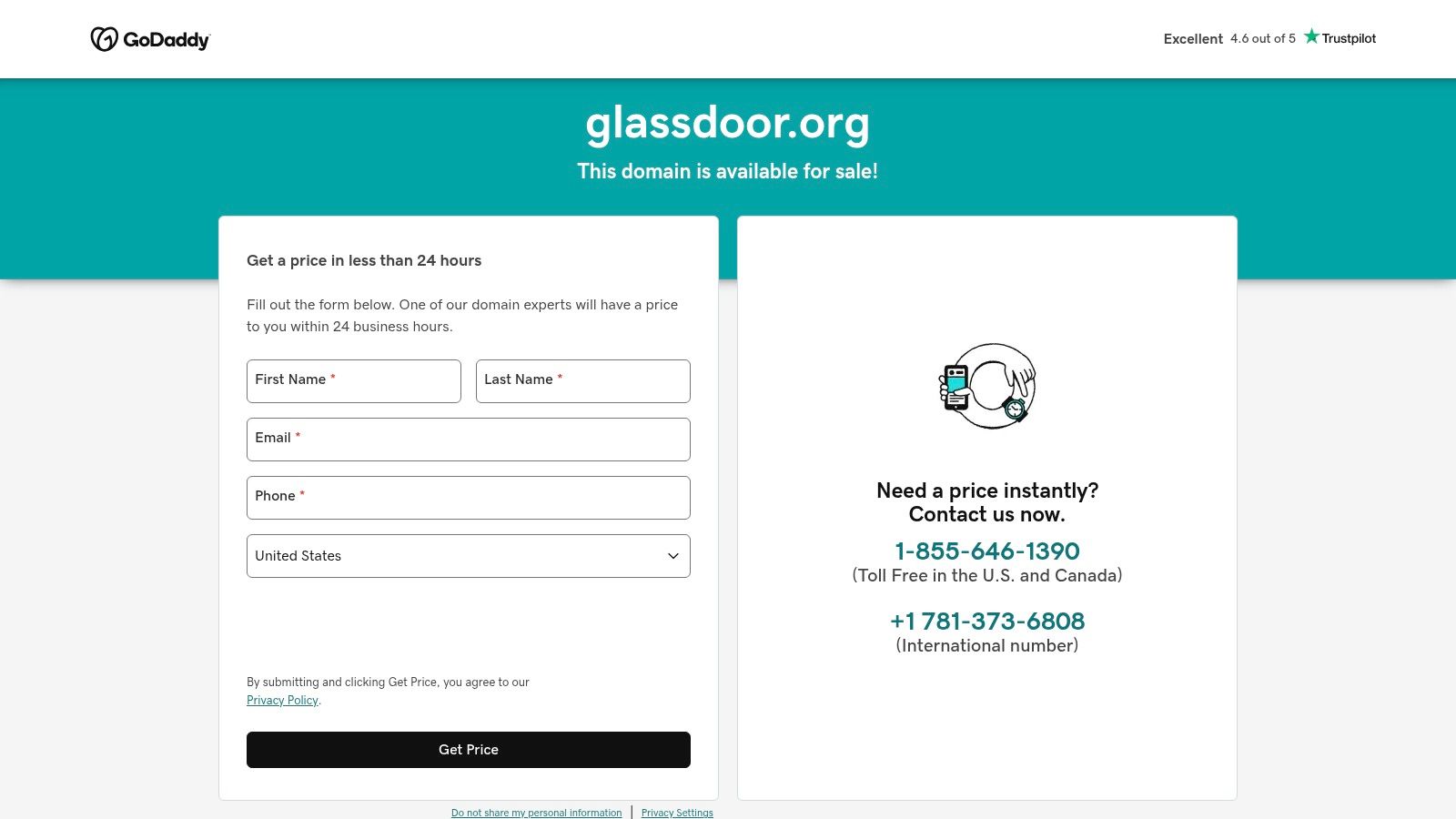
The true strength of specialty glass doors lies in their versatility. They are available in a variety of configurations, including swing, sliding, and pivot options, accommodating various spatial requirements and traffic flow patterns. Furthermore, customization options abound, ranging from custom etching for branding or decorative purposes to privacy films and a variety of hardware finishes. For cutting-edge applications, smart glass technology can be integrated, allowing for on-demand privacy and light control. Learn more about Specialty Glass Doors for a deeper understanding of the options available.
While pricing can vary significantly based on size, glass type, hardware, and installation complexity, specialty glass doors generally command a higher price point than traditional framed alternatives. This is primarily due to the specialized materials, manufacturing processes, and the precision required for installation. For example, a basic frameless glass door can start around $1,500, while more elaborate systems with custom features can reach upwards of $5,000 or more. It's crucial to factor in the additional cost of professional installation, as improper installation can compromise the door's functionality and safety.
Compared to solid doors or even traditional framed glass doors, specialty glass doors offer less sound insulation and can be less energy-efficient due to increased heat transfer. However, advancements in glass technology, such as double-glazing and low-E coatings, can mitigate these drawbacks. While these options add to the initial cost, they can offer long-term savings on energy bills and improve sound control.
For homeowners, contractors, and developers considering specialty glass doors, careful planning and collaboration with experienced installers are essential. Accurate measurements, proper structural support, and attention to detail during installation are crucial for optimal performance and longevity. Despite the higher initial investment and specific installation requirements, the aesthetic impact, enhanced natural light, and sense of spaciousness that specialty glass doors provide make them a worthwhile investment for projects where design and a modern aesthetic are key priorities. They deserve a place on this list because they represent a significant step forward in commercial door design, offering a unique blend of form and function. You can find more resources and information at https://www.glassdoor.org.
Top 10 Commercial Door Types: Quick Comparison
| Product | Core Features ✨ | User Experience ★ | Value Proposition 💰 | Target Audience 👥 |
|---|---|---|---|---|
| 🏆 Gladiator Window and Doors | Extra-large sliding, pivot, bi-fold, panoramic; Custom-made & thermally rated | Superior performance; Best warranty; Premium craftsmanship | Lowest USA prices; Best Offer Guarantee | Homeowners, contractors, developers |
| Hollow Metal Doors | Steel skins; Reinforced core; Fire-rated options | Durable & secure; Low maintenance | Cost-effective; Long-term solution | Commercial |
| Aluminum Storefront Doors | Lightweight; Large glass panels; Modern look | Excellent visibility; Contemporary design | Recyclable; Value in style | Retail, offices, commercial |
| Automatic Sliding Doors | Motion sensor; Energy-efficient; Auto closing | Convenient; Accessible; Modern | Efficiency savings; Higher initial cost | High-traffic entrances, commercial |
| Fire-Rated Doors | Tested fire resistance; Self-closing; Smoke seals | Reliable; Code compliant; Safety-focused | Insurance benefits; Enhanced protection | Public buildings, commercial |
| FRP Doors | Corrosion resistant; Hygienic surface; Thermal performance | Durable in harsh conditions; Low maintenance | Long-term durability; Premium upfront | Food processing, industrial, commercial |
| High-Speed Doors | Rapid opening; Impact-resistant; Safety sensors | Efficient traffic flow; Energy saving | Operational cost savings; Higher investment | Manufacturing, distribution, cold storage |
| Wood & Wood Veneer Doors | Natural wood; Custom designs; Acoustic control | Warm, inviting; Refinish-able | Aesthetic appeal; Moderate cost | Upscale retail, hotels, offices |
| Security Doors | Multi-point locking; Reinforced frame; Bullet-resistant | Superior protection; High security | Premium pricing; Insurance benefits | Banks, data centers, government |
| Specialty Glass Doors | Frameless design; Custom etching; Smart glass options | Maximum light transmission; Contemporary look | Design statement; Higher cost | Upscale retail, offices, conference rooms |
Making the Final Decision
Choosing the right commercial door involves balancing security, functionality, aesthetics, and budget. From the robust durability of hollow metal doors to the sleek modernity of aluminum storefront doors and the specialized performance of fire-rated or high-speed options, this guide has explored a diverse range of commercial door types. Key takeaways include understanding the importance of material selection (steel, aluminum, wood, FRP, etc.) relative to your environment, considering the level of security needed, and factoring in the expected traffic flow. Remember, the right door can significantly impact energy efficiency, accessibility, and the overall impression of your business.
Implementing any of these door types successfully requires careful planning and professional installation. Consider factors such as the size and location of the opening, the required hardware and locking mechanisms, and any specific building codes or regulations. For instance, high-traffic areas may benefit from automatic sliding doors, while fire-rated doors are essential for compartmentalizing spaces and ensuring fire safety. Consulting with a qualified professional is highly recommended to tailor the chosen door type to your specific needs and budget.
Selecting the right commercial door is an investment that protects your business and enhances its value. By carefully evaluating the options presented in this guide and seeking expert advice, you can make a confident decision that will serve your commercial space effectively for years to come.
For expert guidance and a wide range of high-quality commercial door solutions, including many of the types discussed in this article, explore the options available at Gladiator Window and Doors. Visit Gladiator Window and Doors today to discover how they can help you find the perfect door for your commercial property.








